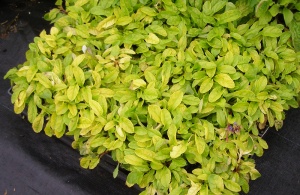Perennials
Umbels of white, cow parsley, flowers. The leaves are a superb rich yellow and a large clump looks magnificent. Clump-forming and may seed about. To 120cm. May/June. Grows best in dry part shade but damper full sun could be tried. Leafs up over-winter and is good in early spring. Summer-dormant. New.
Double flowers in apricot to pink. The early flowers are more orange and the later ones pinker. Stout clumps of greyish-green leaves on purple stems. 60cm. This has the longest flowering season of any Chrysanthemum starting amazingly early in July and still in full flower in September. Well-drained soil in sun. Raised by joe Sharman from seed of the Rubellum types, in the 1990s.
Rich cherry-red very double flowers which are strongly scented. Greenish leaves. Clump-forming. 15cm. Well-drained soil in sun. July/ August. An old rare mule pink and surprisingly vigorous.
Rich dark red, strongly-scented flowers, not quite as dark as in 'Nigrescens'. The leaves are a rich dark black-purple significantly broader than in 'Nigrescens'. The rosettes are tighter and the whole plant is smaller and neater than 'Nigrescens'. Very vigorous and healthy leaves. 45cm. June. Any soil in sun. New. A clone, and not grown from seed. Selected from seedlings at Monksilver by Dr John Grimshaw and kindly named by him.
Large flat heads of many small white flowers. Imposing clumps of divided, feathery, grey-green, hairy leaves. 100cm. Sun or part shade. Any soil. Will flower from June to frosts if dead-headed. Very hardy. In the wild in Turkey is a woodland plant. Often confused with Tanacetum macrophyllum, which has much larger, coarser leaves, is clump-forming rather than semi-shrubby, with larger flat heads of a dull white and seeds over-enthusiastically.
Broadleaf semi-evergreen perennial or bulb with green foliage. In summer, it produces beautiful blue flowers. This plant features a grassy texture and attracts bees and butterflies, making it an excellent addition to pollinator gardens. As for the size, it typically reaches a height of around 60-90 centimeters (24-36 inches).
Spikes of dark blue flowers. Large brownish-green leaves colouring best in sun. Probably the largest-leaved ajuga.20-30cm. Any soil in sun or shade. April.
unique form with many pure white flowers produced even on the laterals but with purple leaves and bracts at flowering time. The summer leaves are greener. Vigorous and spreading. 15cm. April /May. Any dampish soil in part shade. A superb combination of colours. New and discovered by Geoff Hitchens.
Spikes of pinky-mauve flowers over brown-highlighted, green leaves. Summer leaves greener. Vigorous and spreading. 15 to 20cm. April/May and can repeat. Any dampish soil in part shade. Named for, and found by, Julia Leslie. Very pretty.
Brilliant blue flowers on very short stems. Rich dark purple, but very small and crispy, leaves. Spreads much more slowly than the normal types. 5 to 10cm. April/May. Any dampish soil in part shade. One of our favourites.
Bright blue flowers on short spikes. Brilliant golden leaves, especially when growing strongly in Spring and early Summer. 15cm, April/May. Any dampish soil in part shade. Found by Ken Page.
Tubular flowers in red, black, white and green in terminal clusters. Leaves are dark green with a pure white margin. 75 to 100cm. From July to October. Rich, light soil, not too wet in winter, in part shade. Runs when happy. Plant deeply or pot culture.
Pink flowers (green reverse) with centres like tussie-mussies. Three-lobed leaves, and a spreading habit although it seems to be slower-running than the usual form. 60-75cm. Any dampish soil in sun or part shade. Summer. This selection is much more vigorous than the normal form. In the wild found in damp grassland and wood margins.
Small, fully double, narrow-petalled, pale pink flowers. Small rosettes of leaves. Clump-forming to 10cm. April to June. Does best in full sun at the edge of border or in a sink. An old cottage garden plant. Needs to be divided regularly.
Heads of coppery brown bracts surround the tiny flowers. A unique colour which is slightly more orange than in Tall Bronze. Sun preferred, but will do part shade. Clump forming perennial to 30cm and will seed around.
.jpg)

.jpg)
.jpg)
.jpg)
.jpg)
.jpg)

.jpg)
.jpg)
.jpg)
.jpg)


.png)


.jpg)

.jpg)

.jpg)

.jpg)
.jpg)
.jpg)
.jpg)

.jpg)

.jpg)
.jpg)
.jpg)


.jpg)
.jpg)

